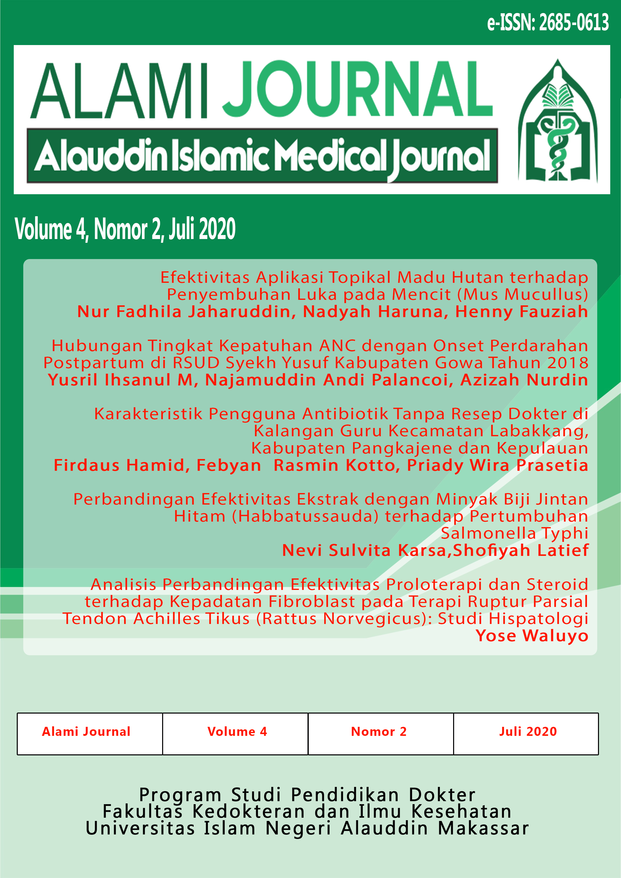Efektivitas Aplikasi Topikal Madu Hutan Dan Propolis Terhadap Penyembuhan Luka Pada Mencit (Mus Musculus)
Abstract
Madu memiliki efek antimikroba, antiinflamasi, antioksidan, dan menstimulasi pertumbuhan jaringan. Propolis memiliki efek antimikroba, antiinflamasi, antioksidan, dan efek terhadap sel mast yang baik terhadap penyembuhan luka. Penelitian ini bertujuan untuk mengetahui efektivitas aplikasi topikal madu hutan dan propolis terhadap penyembuhan luka sayat pada kulit mencit (Mus musculus). Penelitian ini menggunakan 20 ekor mencit jantan yang diberi luka pada kulit punggung mencit dengan ukuran panjang 2 cm dan kedalaman 0,2 cm. Kemudian dibagi menjadi 4 kelompok yaitu tanpa perlakuan, pemberian madu hutan, propolis, dan povidone iodine. Penelitian ini diukur dengan melihat penurunan ukuran panjang luka hingga luka sembuh. Hasil penelitian menunjukkan rerata waktu penyembuhan luka kelompok perlakuan madu hutan ialah tercepat dalam penyembuhan luka yaitu 14,6 hari, kemudian propolis 16,2 hari, tanpa perlakuan 18,4 hari dan povidone iodine 18,8 hari. Pada uji ANOVA didapatkan nilai p > 0,05 (p=0,063) dan dilanjutkan dengan uji pengelompokkan yaitu uji Duncan. Hasil yang didapatkan ialah kelompok perlakuan madu dan propolis secara signifikan memiliki efek yang berbeda dibandingkan dengan kelompok tanpa perlakuan dan povidone iodine. Kesimpulan dari penelitian ini ialah madu dan propolis lebih efektif mempercepat penyembuhan luka dibandingkan dengan povidone iodine dan tanpa perlakuanReferences
Nagori BP, Solanki R. Role of medicinal plants in wound healing. Res J Med Plant. 2011;5(4):392–405.
Barbul A, Efron D. Wound Healing in Schwartz principle of surgery 9th ed. 9th ed. New York: McGrawHill; 2010.
Depkes RI. Profil Kesehatan Indonesia. Departemen Kesehatan RI. Jakarta; 2011.
Oryan A, Alemzadeh E, Moshiri A. Biological properties and therapeutic activities of honey in wound healing: A narrative review and meta-analysis. J Tissue Viability. 2016 May 1;25(2):98–118.
Shihab MQ. Kesehatan Dalam Perspektif Islam (Tafsir Al-Quran Tematik). Tangerang: PT Lentera Hati; 2015.
Malone M, Tsai G. Wound healing with Apitherapy: A Review of the Effects of Honey. J Apitherapy [Internet]. 2016 [cited 2019 Jul 28];1(1):29. Available from: http://www.scopemed.org/fulltextpdf.php?mno=231847
Sakri F. Madu dan Khasiatnya: Suplemen Sehat Tanpa Komplikasi. Yogyakarta: Penerbit Diandra Prstaka Indonesia; 2015.
Gulfraz M, Ifftikhar F, Saira Asif, Raja GK, Asad MJ, Imran M, et al. Ranavirus (family Iridoviridae ) detection by polymerase chain reaction (PCR) in Chinese giant salamander ( Andrias davidianus , Blanchard, 1871), China. African J Biotechnol. 2012;11(85):15130-15134–15134.
Aziz Z, Abdul Rasool Hassan B. The effects of honey compared to silver sulfadiazine for the treatment of burns: A systematic review of randomized controlled trials. Vol. 43, Burns. Elsevier Ltd; 2017. p. 50–7.
Oryan A, Alemzadeh E, Moshiri A. Potential role of propolis in wound healing: Biological properties and therapeutic activities. Vol. 98, Biomedicine and Pharmacotherapy. Elsevier Masson SAS; 2018. p. 469–83.
Kurniawaty E, Farmitalia CG, Rahmanisa S, Andriani S. Perbandingan Tingkat Kesembuhan Luka Sayat Antara Pemberian Etakridin Laktat dan Pemberian Propolis Secara Topikal Pada Tikus Putih (Rattus norvegicus). Seminar Nasional Pakar ke 1 Tahun. 2018.
Zakariya M, Sudiana IK, Wahyuni ED. The Effect of Wound Incision Care Using Honey and Povidone Iodine 10%). J Ners. 2009;1(1):1–8.
Landén NX, Li D, Ståhle M. Transition from inflammation to proliferation: a critical step during wound healing. Vol. 73, Cellular and Molecular Life Sciences. Birkhauser Verlag AG; 2016. p. 3861–85.
Takzaree N, Hadjiakhondi A, Hassanzadeh G, Rouini MR, Manayi A. Synergistic Effect of Honey and Propolis on Cutaneous Wound Healing in Rats. Acta Med Iran [Internet]. 2016 Apr [cited 2019 Aug 4];54(4):233–9. Available from: http://www.ncbi.nlm.nih.gov/pubmed/27309263
Nayik GA, Nanda V. Physico-chemical, enzymatic, mineral and colour characterization of three different varieties of honeys from Kashmir valley of India with a multivariate approach. Polish J Food Nutr Sci. 2015 Jun 1;65(2):101–8.
Hariyati LF. Aktivitas Antibakteri Berbagai Jenis Madu Terhadap Mmikroba Pembusuk (Pseudomonas fluorescens FNCC 0071 dan Pseudomonas putida FNCC 0070). Universitas Sebelas Maret Surakarta; 2010.
Jacob A, Parolia A, Pau A, Davamani Amalraj F. The effects of Malaysian propolis and Brazilian red propolis on connective tissue fibroblasts in the wound healing process. BMC Complement Altern Med. 2015 Aug 25;15(1).
Once an article was published in the journal, the author(s) are: granted to the journal right licensed under Creative Commons License Attribution that allows others to share the work with an acknowledgement of the work's authorship. permitted to publish their work online in third parties as it can lead wider dissemination of the work. continue to be the copyright owner and allow the journal to publish the article with the CC BY-NC-SA license receiving a DOI (Digital Object Identifier) of the work.


